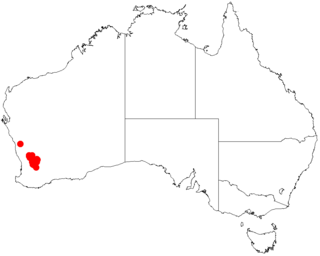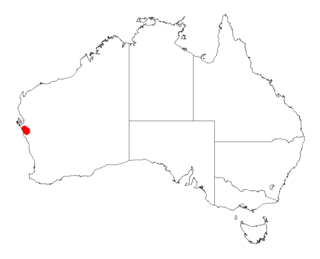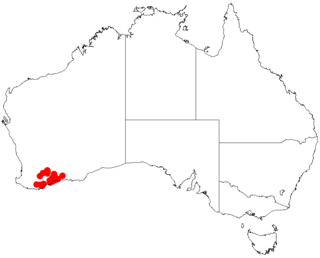
Acacia effusa is a shrub belonging to the genus Acacia and the subgenus Juliflorae that is endemic to north western Australia.

Acacia phacelia, also known as the Kimberley cluster wattle, is a shrub belonging to the genus Acacia and the subgenus Juliflorae that is endemic to a small area in north western Australia.

Acacia rhodophloia, commonly known as minni ritchi or western red mulga, is a tree or shrub belonging to the genus Acacia and the subgenus Juliflorae that is endemic to a large area of arid central western Australia. The Indigenous group the Kurrama peoples know the plant as mantaru.

Acacia richardsii is a shrub belonging to the genus Acacia and the subgenus Juliflorae that is endemic to north western Australia.

Acacia tetraneura is a shrub belonging to the genus Acacia and the subgenus Juliflorae that is endemic to western Australia.

Acacia thoma is a shrub belonging to the genus Acacia and the subgenus Juliflorae that is endemic to arid areas of western Australia.

Acacia concolorans is a shrub belonging to the genus Acacia and the subgenus Phyllodineae that is endemic to Western Australia.

Acacia hastulata is a shrub belonging to the genus Acacia and the subgenus Phyllodineae that is endemic to an area in south western Australia.
Acacia imparilis is a shrub belonging to the genus Acacia and the subgenus Phyllodineae that is endemic to south western Australia.

Acacia marramamba, commonly known as marramamba, is a shrub or tree belonging to the genus Acacia and the subgenus Phyllodineae that is endemic to arid parts of western Australia.

Acacia phaeocalyx is a shrub belonging to the genus Acacia and the subgenus Phyllodineae that is endemic to south western Australia.

Acacia plautella is a shrub belonging to the genus Acacia and the subgenus Phyllodineae that is endemic to a small area along the coast of western Australia.

Acacia pycnocephala is a shrub of the genus Acacia and the subgenus Phyllodineae that is endemic to south western Australia.

Acacia quinquenervia is a shrub of the genus Acacia and the subgenus Phyllodineae that is endemic to south western Australia

Acacia robiniae, commonly known as Robin's wattle, is a shrub of the genus Acacia and the subgenus Phyllodineae that is endemic to south western Australia.

Acacia sphenophylla is a shrub of the genus Acacia and the subgenus Phyllodineae that is endemic to a small area in western Australia.

Acacia brachyphylla is a shrub of the genus Acacia and the subgenus Plurinerves that is endemic to a small area in south western Australia.

Acacia octonervia is a shrub of the genus Acacia and the subgenus Plurinerves that is endemic to a small area along the south western coast of Australia.

Acacia tetanophylla is a shrub of the genus Acacia and the subgenus Plurinerves that is endemic to an area of south western Australia.

Acacia dolichophylla, also known as Chewings Range wattle, is a shrub of the genus Acacia and the subgenus Plurinerves that is endemic to arid parts of central Australia.




















